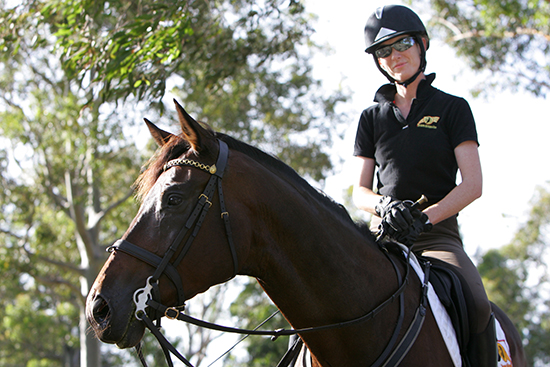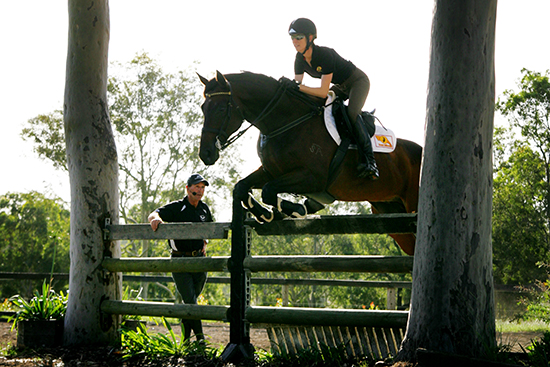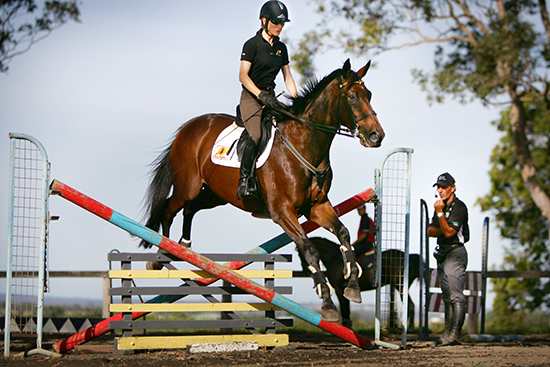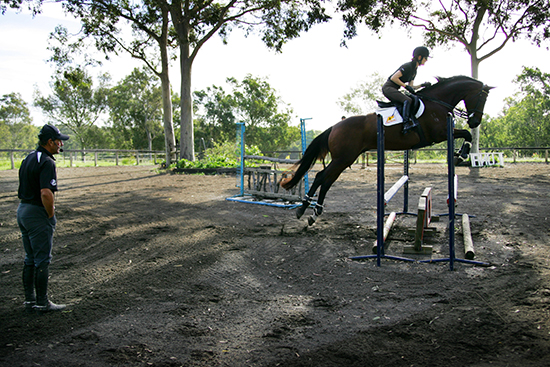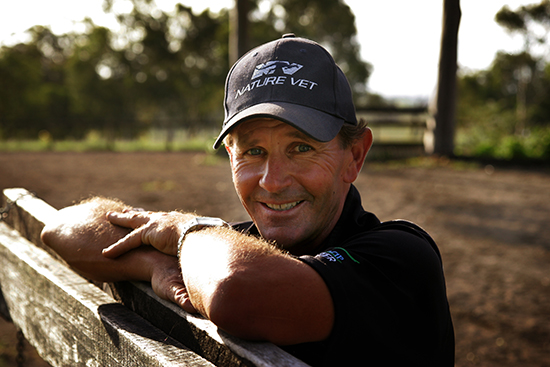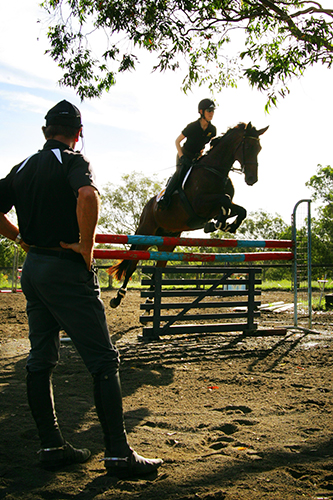 Story by Tarsha Hammond & Photos by Peter Stoop
Story by Tarsha Hammond & Photos by Peter Stoop
If you have a favorite horse, it’s a given that you really want your coach to like it. Really like it. If you get the “good horse” seal of approval, life is good. You approach your first lessons with excitement but also slight trepidation, to get the coach thumbs down could be ruinous to future success.
After our first few lessons with Jamie, we were probably averaging a C minus. Rio’s behavior was as ordinary as he could produce and I felt (I imagine) how parents must feel when their children have an embarrassing throw down at the supermarket. The effort that was put into these “not going onto the arena dummy spits” was definitely A+ and the effort reserved for jumping endeavors rated sadly in comparison.
Rio could show glimpses of potential but these were cloaked quickly lest he have to extend himself further. My claims that I was riding a future champion were met politely, but possibly incredulously. Jamie has been patient and tolerant, excepting the odd “if this horse doesn’t get its act together soon, it’s going to get the sack”.
Rio’s efforts to skip, rip out or blot completely the pages of his exercise book were impressive, as was his aversion to anything vaguely gymnastic. Jamie does gymnastic in a big way. Submission also is not up for discussion, it’s an absolute requirement. Rio and I were still climbing that mountain. But as we all know with age comes maturity and with a bigger bit comes control. With A LOT of gymnastics, submission exercises, and that motivation that only a good coach can give, we achieved the heart warming, rider glowing comment of “this horse is looking like a show-jumper”. Big praise.
Rio’s lesson starts with engagement work in the canter (that’s the deep end of the pool for him), getting him really working his back end and submissive in the bridle. Lengthening and shortening the stride, yielding from the leg and then moving onto flying changes. Jamie wants them clean, with no loss of balance through the shoulder or compromise on the submission.
The gymnastics begin with the “S” bend exercise over the small planks demanding complete control and bend through both sides of the body. The jump is just an elevated canter stride and the connection to the bridle is paramount. This is guaranteed to emphasize any weaknesses of schooling, or furry responses to my aids by my tank of a horse – which will be duly noted by my super coach. More dressage needed.
When we start jumping we keep his neck low and the connection encouraging a rounder jump.
This is my personal favorite, it feels very like dressage and after the gymnastics of the last half an hour surprisingly attainable.
Then, the stickler. Big canter, natural jump. Big canter without going x-country, floaty canter without throwing your body forward. I have got it once or twice. Okay, once only really but it felt great. Actually it felt amazing to ride, he felt like a balloon in the air. Jamie was happy, or was that enthusiasm absolute relief? He managed to not roll his eyes while I was looking and made only the most encouraging remarks about that being the ride in the ring we are going to get one day. One day… look out.
SHOWJUMPING AND EVENTING
An interview with Jamie Coman
Eventing has changed, and I would have to admit, for the better. I was a big fan of the long format as I really liked the emphasis on the speed and endurance of our horses. I don’t miss it at all though. The short format puts a greater emphasis on the showjumping phase and it’s been great. Our horses are presenting on the third day of an event fitter, sounder and facing bigger more technical tracks.
Consequently a lot of riders have turned to the pure showjump coaches in an effort to keep up. A high proportion of Australia’s top eventers have chosen to work with Jamie Coman. Jamie has been one of Australia’s elite showjumpers for many years. He represented Australia at the Olympics in 2000 on LL Zazu. He was the National Showjumping Coach from 2004 -2006 and has produced umpteen top horses.
The Comans moved to the Hunter Valley in 2003 and many eventers in our area have been taking advantage of his exceptional coaching skills. He teaches clinics all over Australia and a high proportion of these are for eventers. Jamie, his wife Sue (Australian representative and World Cup showjumper) and daughter Hayley (Australian Junior Champion 2004) are in the process of moving to Melbourne. During this hectic time I finally managed to pin him down to answer a few questions about the joys of teaching event riders. Morpeth pub was the noisy venue. With the sounds of revelry in the background it seemed very appropriate to discuss showjumping, yet very difficult when I went to translate it to paper. However, I managed to get some pearls of wisdom from this super coach. (I am happy to sell the unedited tape version for a small fee!)
Has the increased focus on showjumping in eventing been reflected in the amount of lessons you are teaching to eventers?
Most definitely. You guys are becoming very strong and it’s getting so much tougher. You have to be good in all three phases. You win or lose classes on a rail. What I find when I work with the eventers is when I’m teaching them at home we are working with a fresh horse. Whereas at an event, the horse has done a dressage test, gone x-country and is then required to produce a good showjump. I’m always trying to work with that. I haven’t changed what I do a lot. I’ve just changed the riders that I’m working with.
Showjump riders should have the same grounding that the eventers do. You have to do a dressage test, so you learn to ride a dressage test where a lot of our guys don’t do it, they short track it. The elite guys do and that’s why they are what they are. You have to do the groundwork, and it has to be happening well. That’s why I’m liking working with you guys, because you start with the right grounding, so at least you know the leg to hand connection and you start with some kind of submission.
When I come for a lesson you basically give me a dressage lesson to start with and then move onto the showjumping. You emphasize the connection, the submission constantly…
Yes, absolutely. I want submission, and I really want the horse to work over that back, like a dressage horse. I believe that by the time a horse is a Grand Prix showjumper it should be trained to basically be a Grand Prix dressage horse. That’s how well you want them to ride and you need them that well trained. But one of my riders commented to me, that I school hard, and I school the submission but when I go into the ring I ride them a little natural, a little out there and leave them be. That’s how I want to be because I want them to have their natural jump. I want the riders to be classical in their ride but leave the horses in their own natural shape, which will normally be not so much submissive but in a good shape producing a good jump. All the work that you’ve done leads you to the day when you are jumping in the main arena. The horse is going to stay in its shape because it’s trained and muscled that way so that’s where it’s going to stay.
Are there common problems you see with eventing horses and riders? Do you see someone jumping and do the ‘spot the eventer’ thing?
Well (long pause) yes, you can spot it a mile away, but no I’m not going to say that anymore.
Why not?
Because event riders are changing, they are becoming more classical all the time. They still have to learn to let go of their dressage shape and to let the horse be a little more out there. They have to learn that they are not cross country riding and they don’t have to be in a light seat and be up their neck all the time. They can like to duck a bit. So most of my event riders, if I can just get them to get back to thinking, that the jump is just an elevated canter stride, then we have success straight away. Eventers need to learn to let the horse carry them.
The eventers who have a showjumping background very much stand out and it’s evident in the results. But for a lot of us, it’s our weakest phase.
Yeah, it’s amazing that you guys go cross country and yet are scared of the showjumping? Not scared of the jumps or the height but maybe knocking the rails down. I’d be a little scared too, because you are riding with only two thirds of the horse that you trained with the week before, because you have done two other phases. That makes it really hard.
The gear means the horse has to be careful, the courses are technical and you are being asked questions all the time. The horses are amazing, but you are going into the showjumping arena with maybe only one rail, or not even that, up your sleeve and holding it together and learning to jump a showjumping round. I think you guys get three quarters of the way around your cross country course and have to carry the horses home sometimes, really help it over the last few jumps. But we don’t want to do that when we showjump. As soon as you start helping it like that it starts to jump lower. You have to trust the horse’s jump. If we have the flatwork in place, then after the cross country we have the ability to put the horse back where we want it to jump well. I talk to my riders and discuss with them what we need to do to get the best jump by the third phase.
Cross country can sometime get a little rough-and-tumble. Are you careful not to make the event horse too careful so that when we go across country and they may hit a fence, they don’t start stopping?
Most definitely you don’t want a horse to be too careful when it’s going cross country. If you’ve got something that’s jumping too big in the air, you have to gallop it harder to make the time. You want your horse confident and jumping. With my riders I like to work with the idea that I want them to ride their cross country like their showjumping only in that they learn to turn up to the fences so they are time economical, and that the horse comes back to them when they ask. If you are fighting for control, you both get tired and you lose everything. You don’t want to get them too airborne, you just can’t afford to have them too careful because it’s not economical. We need to be economical so we have more energy and more horse left for the showjumping. We have exercises that we do in the lessons so that when we are warming up they know they are back showjumping and then we get them airy. We have a different riding style, which is not hard. We are just sitting back in the saddle and getting the horse soft again.
So that’s when you talk about making the ride better?
Yes, the ride has to be better. The rider has to be able to make the canter and produce the jump from that. Make the jump better from the good schooling that you have given the horse and trust it to jump. I want my riders to be almost equitation-perfect and produce the good jump from a good ride.
So do you recommend a different warm up to riders jumping tired horses at a 3DE?
Yes, the warm-up I gave my riders at Sydney 3DE was exercises we had trained prior in the last few lessons. We have a shorter warm-up and don’t jump a lot of fences.
Time is obviously really relevant to us but we don’t jump off against the clock.
That’s really amazing to me. You have to go so hard cross country to make time and yet never in showjumping do you have to jump off. I find that a little boring, I would love to see you jump off, and you’d be good at it. You guys know how to take strides out of lines. I will walk a line of 5 strides and you guys are saying that cross country you would do that in 3 strides! The only thing that I have found when I talk to my riders is that some of them are getting a little stuck on the first few fences on the cross country and showjumping them. You can’t afford to lose time early on though, and the elite riders know that. You have to realize that showjumping is one thing and cross country is another. I teach showjumping.
Quality canter?
Quality canter, quality jump. That’s what it comes down to. We might start off in a lesson very slow, very contained; very much making them learn to sit. Then we crank it up and we go to the next gear. I need to know that you can gallop to a fence and then land and within 6, 5, 4 or even 3 strides, sit the horse and make it submit wherever you are.
When you are mid-lesson with an eventer, is there ever that moment when all seems normal and then suddenly they see a longy and leg it in?
Yeah and the reins get slipped and they drop back into the safety seat. Sure, there are those times, but then you guys can get on and ride dressage and cross country. I really don’t draw a line between my event riders and showjump riders. Whatever stage you are at it has to be perfect. You want to work the best you can. I want my riders to have another rider hop on their horse and say, that’s amazing, you’ve done the most amazing job. You have trained it super, you ride it beautifully, that’s my goal.
Sydney was great with the Eventers and the Showjumpers competing at the same venue. We had the 3DE and you had your National Championships…
It was great! The best show I’ve been to. It was fantastic I wanted to get out and watch some cross country but because of the show jumping schedule it didn’t happen. I’m sure if they have this combination again, we could organize it so the jumpers could get out to watch.
Do you recommend eventers compete straight showjumping?
I think it’s very, very good. At the end of the day, the showjumping will only keep getting tougher. In the next couple of years the depth of the cups for eventing will probably be the same as what we have for showjumping. Because that is the only difference, the depth of the cups. At SIEC when we had both disciplines jumping in the same ring, the cups were changed for the eventers.
I believe eventers are making so much progress. The event riders I train these days, if they couldn’t event tomorrow, there would be no problem with them going showjumping. They know how to showjump.

